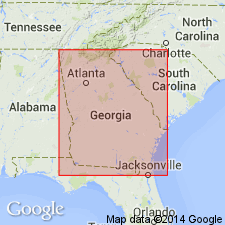
- Usage in publication:
-
- Buffalo Creek Kaolin Member
- Modifications:
-
- Named
- Revised
- Dominant lithology:
-
- Clay
- AAPG geologic province:
-
- South Georgia sedimentary province
Summary:
The informal Buffalo Creek formation of Pickering and Hurst (1989: Georgia Geological Society Guidebook, v. 9, no. 1, p. 29-75) is here revised and formally proposed. As originally introduced, the formation encompassed all Cretaceous age kaolinitic deposits in the report area (the "Tuscaloosa formation," Pio Nono Formation, and Gaillard Formation of the Oconee Group of this report). The name is adopted here as the Buffalo Creek Kaolin Member, and the unit is restricted to include only the kaolin at the top of the Gaillard Formation of the Oconee Group (both new). The name is applied to the kaolin of the uppermost fining-upward sequence of the Gaillard, which is locally widespread. Includes not only the commercial grade kaolin of the central GA and western SC kaolin mining districts, but also the thin beds of relatively pure kaolin or micaceous, finely sandy kaolin beds or lenses at the top of the Gaillard elsewhere. 15 m of the member is mined at the type section on Buffalo Creek. Underlies the Marion Member of the Huber Formation. Late Cretaceous age of the Buffalo Creek is based on stratigraphic position and its correlation with the upper part of the Blufftown Formation and with the Cusseta Sand.
Source: GNU records (USGS DDS-6; Reston GNULEX).
For more information, please contact Nancy Stamm, Geologic Names Committee Secretary.
Asterisk (*) indicates published by U.S. Geological Survey authors.
"No current usage" (†) implies that a name has been abandoned or has fallen into disuse. Former usage and, if known, replacement name given in parentheses ( ).
Slash (/) indicates name conflicts with nomenclatural guidelines (CSN, 1933; ACSN, 1961, 1970; NACSN, 1983, 2005, 2021). May be explained within brackets ([ ]).

